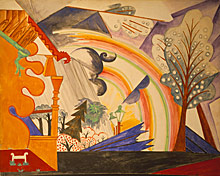Yesterday I headed up to the Philadelphia Museum of Art to see their Chagall exhibit “Paris Through the Window”. I know Chagall from his murals at the Metropolitan Opera (they flank the grand staircase and can be seen lit up behind the windows of the Met as you stand at the Lincoln Center fountain.) I also remembered Chagall mentioned in a memoir written by Rudolf Bing, the famous General Manager of the Metropolitan Opera in the golden age of the 60’s and 70’s. He and Chagall had visited with each other during his tenure as Chagall created the murals.
 |
| The front of the Metropolitan Opera |
 |
| Chagall, “Self-Portrait”, on display at the exhibit |
What I didn’t realize was that Chagall had also designed sets and was one of the collaborators of the great Ballet Russes, created by impresario-director Sergei Diaghilev and performed between 1909 and 1929. The Ballet Russes included the music of some of the great classical musicians of the 20th century, including Igor Stravinsky and Nikolai Rimsky-Korsakov. When I arrived at the exhibit, I was pleased to see that it included work from the Ballet Russes and I learned even more about the visual aspects of the famous performing arts company.
 |
| Set Design for “Soleil de Nuit” Ballet Russe |
You may know that Stravinsky’s “The Rite of Spring” has its premier at the Ballet Russes in Paris in 1919 and caused a riot. When my music history professor at Princeton told us this story, we were excited to hear that classical music could cause such an uproar. Later he then pointed out that it was most likely because of the overtly sexual choreography. Hmm… well let’s just say it was both! 😉
The PMA’s show, which is on the first floor at the museum’s Perelman Building, includes works by Chagall as well as many of his contemporaries living in Paris in the 1910s and 20s. This context gave the visitor a better idea of the rich artistic environment that existed at that time, with Paris as an artistic Mecca and catalyst for new vision; for creative minds from around the Western world, especially from Eastern Europe. (Chagall was from Russia.)
 |
| Chagall, “Paris through the window” 1913, on display at the exhibit |
Of course when I arrived at the exhibit, I started listening intently. First it was to the guided audio tour on my cell phone by curator Michael Taylor, (for more visit http://www.philamuseum.org/exhibitions/401.html to download a video tour on your iPhone or iPad) but then I noticed that there was also music playing overhead. I wondered if it was music from the Ballet Russes, and indeed it was. I contacted their audio-visual manager who put me in touch with Anna Vallye, curator of the music for the show.
 |
| Costume Design for the Ballet Russes “Chout” |
The soundtrack added a third dimension to the show that created an even better chance for the visitor to get a sense of the many different art forms converging at the time. But though the music sounded decidedly classical, the Ballet Russes costume and set designs that are on display look fresh and fantastical. I learned about their creators Natalya Goncharova and her partner Mikhail Larionov. As one board at the exhibit described, they “fused the archaic with the modern through Neo-Primitivist emulation of peasant art informed by Cubo-Futurist experimentation.”
Are you still with me? You may need to read it twice, but it makes sense and was given good context at the exhibit which includes a number of Chagall’s cubist works as well as his contemporaries’.
 |
| Stage design for the ballet “The Midnight Sun” by Rimski-Korsakov, from the opera “Snow Maiden” 1915, on display at the exhibit |
I would have loved to have attended the original Ballet Russes, with their costumes, sets, choreography and music. To me the explosion of color and form creates an even bigger space for the music and dance, as if the world has been blown apart not to destroy, as a means to reveal it in even greater brilliance.
The show fills three annexed rooms and is inspiring, informative, and good for any attention span. You could certainly visit for an hour or two on a weekend afternoon, or to get away from work for an essential mind-expanding break.
On a side note, choreographer George Balanchine also got his start as a young man with the Ballet Russes, and the Pennsylvania Ballet will do a “Building on Balanchine” performance as part of PIFA at the Merriam Theater which runs April 14-17m. http://www.pifa.org/events/980191348
The Chagall show runs from March 1 through July 10th at the Philadelphia Museum of Art and is $12 with the purchase of any PIFA event ticket. http://www.pifa.org/events/980191840
And tomorrow I’ll be attending the grand gala opening of PIFA with “Pulcinella”, one of the Ballet Russes written by Igor Stravinsky and featuring new choreography by Finnish native and Boston Ballet resident choreographer Jorma Elo, to be performed live onstage by the Philadelphia Orchestra and Pennsylvania Ballet. The two companies rarely perform together, and I’m especially excited to see the Ballet performed by one of the greatest Orchestra’s in the world. (Sorry, Pennsylvania Ballet, but I’m a classical musician, and therefore heavily biased 😉
**for those of you who would like to read more about the music at the exhibit, please read the following email sent to me by music curator Anna Vallye.
—
**from an email from Anne Vallye
”Dear Emily,
Thank you for your interest in the music featured in our “Paris Through the Window” show. I chose excerpts of two separate classical compositions that were part of the Ballets Russes repertoire:
“Narcissus is Transformed into a Flower,” from Narcisse et Echo (1911) by Nikolai Tcherepnin
and
“King Dodon and the Shemakhan Queen,” from Le Coq d’Or (1907) by Nikolai Rimsky-Korsakov.
These selections represent the two most prominent strands within the pre-war Ballets Russes productions, both of which are also illustrated in the exhibition through stage and costume design sketches.
The first selection was composed for the closing scene of the only Diaghilev production that Chagall worked on personally, executing decor designs by his teacher Leon Bakst. A costume design sketch from Narcissus is displayed in the vitrine, and in addition, the main wall text for that section of the show cites a lovely description of this very same closing scene of the ballet written by the French poet and Ballets Russes intimate Jean Cocteau. It is a scene of magical transformation that conveys especially well the aura of visionary enchantment about the first Saisons Russes. It is a fairly rare recording and a much sought-after masterpiece by this Russian composer.
The ballet-opera Le Coq d’Or (Golden Cockerel), from which the second selection is excerpted, is characteristic of the Russian folk revival aesthetic representing a parallel development of early Ballets Russes exoticism, alongside that of Classical Greek and Far Eastern themes. A décor design for Le Coq d’Or by Russian avant-garde artist Natalya Goncharova is a featured illustration in one of the rare period books included in the vitrine. But there are also multiple Russian-folk-art-inspired stage and costume designs by Goncharova and her partner Mikhail Larionov in the exhibition, including an early version of a curtain design for the ballet Les Noces, directly related to the designs for Le Coq d’Or. These are some of the highlights of our Ballets Russes display. As a modern re-imagining of Russian folk music, Rimsky-Korsakov’s piece is a fitting counterpart to Goncharova’s and Larionov’s designs. Rimsky-Korsakov was a leading figure in the turn-of-the-century Russian nationalist revival, inseparable from Russian modernism in the fine arts at large. Diaghilev, Chagall’s teachers Bakst and Roerich, and certainly Chagall himself, are all representatives of this cultural trend. In addition, Diaghilev studied with Rimsky-Korsakov as a youth. The Le Coq d’Or excerpt is joyful and romantic, which is different in mood from the Narcissus piece.”
***
This story is brought to you with the support of PIFA (Philadelphia International Festival of the Arts) <http://www.pifa.org/> . Please Like their Facebook <http://www.facebook.com/PIFA.Philly> Page and Follow them on Twitter <http://www.twitter.com/PIFAPhilly> !


Siren IVA. Check out Dolce Suono Ensemble. As a part of PIFA concerts, they are performing at the First Unitarian Church, Philadelphia on April 13th with the theme "Belle Epoque, Nouvelle Epoque".
http://www.dolcesuono.com
I have known of Mimi Stilmann, the flautist since she was a grad student at Penn and used to give concerts in classrooms. You will like them.
Such a nice article sherin. I like PIFA concerts section too much to read here.
dean graziosi